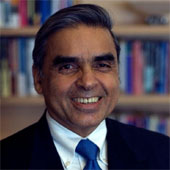China Returns to Its Global Roots
Can China’s future actions as a world power be predicted by a close look at its previous Golden Age?
April 21, 2008
China’s nascent efforts to rediscover its past and reconnect with it are likely to be exciting for both China and the world. It will bring about a massive change in international cultural chemistry.
To get a glimpse of what China will behave like when it becomes a rich and successful civilization, we need only to look back and see how China behaved during previous peaks of Chinese civilization.
Six decades of communist rule have not changed the Chinese soul, which has developed over thousands of years of history. There is a rich and wondrous well of Chinese culture.
Many Chinese historians will agree that the greatest Chinese dynasty was the Tang Dynasty. The period of the Tang Dynasty (618-907 CE) is one of the “golden eras” in the history of China. The Chinese empire achieved unprecedented economic and cultural heights, made a number of important inventions, doubled in territory, and consolidated its political influence across the continent of Asia.
The Tang rulers welcomed foreign ideas, making Chang’an — the Tang capital — the most diverse city in the world. Merchants, clerics and envoys from India, Persia, Arabia, Syria, Korea and Japan thronged the streets of Chang’an, and foreign tongues were a common part of daily life.
Under this period of Pax Sinica, the most important ancient trade route of that time, the Silk Route, reached its golden age, when Persian and Sogdian traders benefited from the exchange between West and East.
In the beginning decades of Tang dynastic rule, especially under the leadership of Emperor Taizong (627-650), China subdued its nomadic neighbors from the north and northwest, securing peace and safety on overland trade routes reaching as far as Syria and Rome.
The 7th century was a time of momentous social change — the official examination system enabled educated men without family connections to serve as government officials.
This new social elite gradually replaced the old aristocracy, and the recruitment of gentlemen from the south contributed to the cultural amalgamation that had already begun in the sixth century. When the Tang Dynasty was at its peak during the period 710 to 755, China was far ahead of any other contemporary civilization. Indeed, none even came close to matching its level of development.
A rejuvenation of Chinese civilization along the lines of the Tang Dynasty would be a blessing for the world. This revived Chinese civilization would be open and cosmopolitan, not closed and insular. Indeed, a confident Chinese civilization may prove even more open and cosmopolitan than the insecure societies of the West.
Already, China is doing a remarkable job of introducing the highlights of Western culture to its population. While many orchestras and opera houses are struggling in Europe and the United States, China, with an estimated 30 million piano students and ten million violin students, is on an opposite trajectory.
Tests to enter the top conservatories now attract nearly 200,000 students a year, compared with a few thousand annually in the 1980s, according to the Chinese Musicians Association.
“I honestly think that in some real sense the future of classical music depends on developments in China in the next 20 years,” said Robert Sirota, the president of the Manhattan School of Music. “They represent a vast new audience as well as a classical music-performing population that is much larger than anything we’ve had so far,” he continued.
“You’re looking at a time when, maybe 20 to 40 years from now, Shanghai and Beijing are really going to be considered centers of world art music.”
Editor’s Note: This excerpt is adapted from THE NEW ASIAN HEMISPHERE by Kishore Mahbubani. Copyright 2008 Public Affairs. Reprinted with permission of the publisher.
Takeaways
While many orchestras and opera houses are struggling in Europe and the United States, China is on an opposite trajectory.
Six decades of communist rule have not changed the Chinese soul, which has developed over thousands of years of history.
The Tang rulers welcomed foreign ideas, making Chang'an — the Tang capital — the most diverse city in the world.
Read previous
Congo’s Oil Quagmire
April 19, 2008
